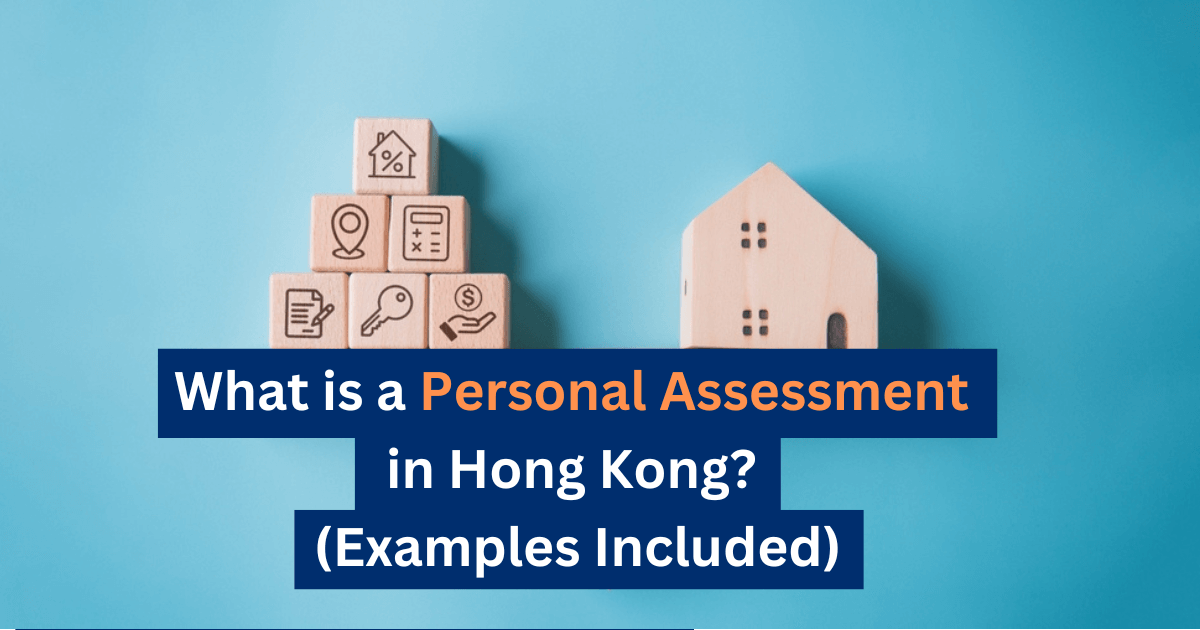Personal assessments are the aggregation of alternate sources of taxable income, such as property income and business profits, to be taxed as a single source of income, with the goal of paying less taxes overall. By taking advantage of various deductions and allowances available under Hong Kong tax law, you can optimize your tax liability efficiently and balance out losses or interest payments made during the current tax year. We’ll also show examples of personal assessment computations to showcase scenarios of when to or when not to elect for personal assessment.
Who is eligible to apply for personal assessment?
Any permanent or temporary Hong Kong resident over the age of 18 (or under if both parents have passed away), can elect for personal assessment.
What deductions and allowances are available under personal assessment?
According to the Hong Kong government’s website, the following tax reductions and allowances may be deducted from your aggregated income under personal assessment, pending eligibility:
- Interest payable on money borrowed to acquire a property used for letting
- Approved charitable donations
- Self-education expenses
- Elderly residential care expenses
- Home loan interest
- Mandatory employee contributions to MPF schemes
- Contributions to recognised occupational retirement schemes
- Qualifying premiums paid under the Voluntary Health Insurance Scheme (VHIS) policy
- Qualifying annuity premiums and tax-deductible MPF voluntary contributions (TVC)
- Business losses incurred in the year of assessment
- Losses brought forward from previous years under personal assessment
- Personal allowances, such as:
- Basic allowance (applicable to all taxpayers in Hong Kong, except when a Married Person’s allowance has been claimed)
- Married Person’s allowance
- Child allowance
- Dependent Brother/Sister allowance
- Dependent Parent/Grandparent allowance
- Single Parent allowance
- Disabled Dependent allowance
- Some Personal Disability allowance
Who should elect to do a personal assessment?
Personal assessments are primarily meant as tax relief for individuals who are subject to profits tax and property tax, as well as individuals that have multiple dependents but earn no salary. Some common examples of taxpayers that could benefit from electing personal assessments include:
- Landlords with high amounts of rental income but no salary income.
Single individuals who only receive rental income can take advantage of deductions on the interest of money borrowed to buy the rental unit..
- Married, full-time business owners that use their profits as income while raising 2 children.
Individuals here are eligible for allowances related to the number of children they have, a marriage allowance, and tax reductions to help offset their profits tax, as well as further reductions should they suffer losses in their business.
- Single parents that run their own business and have dependent parents of their own.
Individuals in this scenario are eligible for allowances related to their children, other dependents like their parents or grandparents, on top of deductions available to them as a business owner.
Who should NOT elect to do a personal assessment?
If you are subject only to salary tax, you may not see any real benefit from doing personal assessment, and in fact may end up with a larger tax bill.
In fact, income earners in Hong Kong with an annual income of greater than $200,000 get taxed at a tax rate of 17%, higher than the standard 15% applied to property rental incomes and business profits. When applied to a personal assessment, the resulting tax bill may be higher than if the income streams were taxed separately.
However, if you did apply for personal assessment but ended up with a higher tax bill, the IRD will automatically issue tax demand notes as though you did not apply for personal assessment. Even if personal assessments may not be applicable to you, there are other ways to reduce your tax bill.
Joint assessments for married couples
Married couples can apply for joint assessments, or separate personal assessments from their spouse. Joint assessments would aggregate both spouses taxable income as a single unit, potentially lowering their tax liability overall.
The tax is allocated proportionally according to each spouse’s income, and each spouse will be notified by the IRD separately.
Personal Assessment Tax Computation Examples
In the first example, Miss Chan owns a business that has earned assessable profits of HK$250,000 in the current tax year, and is earning a rental income of HK$35,000 per month on a property under mortgage for. She paid $37,000 in mortgage interest for the current tax year.
Note that the tax reduction for the tax year of 2024/2025 is capped at HK$3,000.
Under personal assessment, Miss Chan was able to save 30% on her tax bill under personal assessment (1B) compared to taxing the income streams separately (1A) for the following reasons:
- She was eligible for a basic allowance under personal assessment.
- She was eligible for a tax deduction equal to the amount she paid in mortgage interest.
- Aggregating her property and profit taxes also allowed the tax to be calculated once at the standard rate of 15%, compared to twice if the taxes were calculated separately.
1A. Profit & Property Taxes Calculated Separately without Personal Assessment
| Profits Tax | HK$ |
| Assessable Profits | 250,000 |
| Profits Tax @ Standard Rate of 15% | 37,500 |
| Minus: 100% tax reduction (capped at $3,000)* | 3,000 |
| Tax Payable | 34,500 |
| Property Tax | |
| Net Assessable Property Value ($35,000 x 12 x 80%) | 336,000 |
| Property Tax Payable @ Standard Rate of 15% | 50,400 |
| Total Tax Payable | 84,900 |
1B. Profit & Property Taxes Calculated Together under Personal Assessment
| Aggregated Tax | HK$ |
| Net Assessable Property Value ($35,000 x 12 x 80%) | 336,000 |
| Plus: Assessable Profits | 250,000 |
| Equals: Total Income | 586,000 |
| Minus: Mortgage interest | 37,000 |
| Minus: Basic Allowance | 132,000 |
| Equals: Net Chargeable Income | 417,000 |
| Personal Assessment Tax @ Progressive Rate (15%) | 62,550 |
| Minus: 100% tax reduction (capped at $3,000) | 3,000 |
| Total Tax Payable | 59,550 |
Next we’ll compare this to Mr. Lee, who pays more taxes under Personal Assessment.
In this scenario, Mr. Lee owns a business that made assessable profits of HK$250,000 for the current tax year, and also earns a salary income of $HK300,000.
Mr Lee ended up paying almost 80% more in taxes under personal assessment (2B) compared to paying the taxes separately (2A), for the following reasons:
- Profits tax and salaries tax are each eligible for a tax reduction capped at $3,000, but when aggregated, is only eligible for one tax reduction.
- Mr. Lee’s income is at the highest tax bracket of 17%, which was also used on his aggregated income to calculate his tax bill under personal assessment.
2A. Profit & Salary Taxes Calculated Separately without Personal Assessment
| Profits Tax | HK$ |
| Assessable Profits | 250,000 |
| Profits Tax @ Standard Rate of 15% | 37,500 |
| Minus: 100% tax reduction (capped at $3,000)* | 3,000 |
| Profits Tax Payable | 34,500 |
| Salaries Tax | |
| Salary Income | 300,000 |
| Minus: Basic Allowance | 132,000 |
| Equals: Net Chargeable Income | 168,000 |
| Salaries Tax @ Progressive Rate 17% | 28,560 |
| Minus: 100% tax reduction (capped at $3,000)* | 3,000 |
| Salaries Tax Payable | 25,560 |
| Total Tax Payable | 60,060 |
2B. Profit & Salary Taxes Calculated Together under Personal Assessment
| Aggregated Tax | $ |
| Assessable Profits | 250,000 |
| Plus: Salary Income | 300,000 |
| Total Income | 750,000 |
| Minus: Basic Allowance | 132,000 |
| Equals: Net Chargeable Income | 737,000 |
| Personal Assessment Tax @ Progressive Rate of 17% | 110,550 |
| Minus: 100% tax reduction (capped at $3,000)* | 3,000 |
| Total Tax Payable | 107,550 |
You can check out the IRD’s website for more examples.
Conclusion
A personal assessment is a tool that you could use to lower your tax burden, but only under the right conditions. Primarily used as tax relief for business owners and property owners, Hong Kong residents paying only a salaries tax would not see any benefits through electing a personal assessment, and may instead end up paying a higher tax bill. Fortunately, the IRD is able to recalculate your tax bill as though you did not elect a personal assessment if you do end up paying more because of it.
If you’re not sure whether you are eligible for certain allowances and deductions under personal assessment, drop us a message and we’ll be happy to help out.










